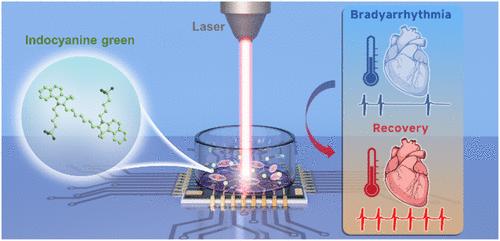基于心肌细胞生物传感的高效ICG分子振动治疗慢性心律失常
IF 9.1
1区 化学
Q1 CHEMISTRY, ANALYTICAL
引用次数: 0
摘要
慢速心律失常是心血管疾病发病率和死亡率的主要原因。目前,药物和/或手术是治疗慢速心律失常的常规临床治疗策略,但药物副作用、侵入性手术或潜在并发症限制了其广泛应用。因此,开发慢速心律失常的替代疗法是迫切需要的。在此,我们提出了一种普遍有效的药物模拟策略来治疗慢速心律失常,该策略依赖于近红外触发吲哚菁绿(ICG)的光热特性。通过动态分析心肌细胞电生理活动,建立了一种基于原位集成细胞的生物传感调节平台来评估治疗效果。上述结果表明,ICG热振动能有效增强慢速心律失常心肌细胞的电生理,并能长时间维持节律状态,优于金纳米棒等离子体局部加热。此外,定性研究证实,热刺激是光热治疗过程中增强心肌细胞电生理活动的关键因素。本研究为慢速心律失常提供了一种无创药物模拟治疗策略,建立了可靠的基于细胞的生物传感调节电生理评估和药物筛选平台,有助于慢速心律失常治疗的进一步发展。本文章由计算机程序翻译,如有差异,请以英文原文为准。

High-Efficiency ICG Molecular Vibration Therapy for Bradyarrhythmia Using Cardiomyocyte-Based Biosensing
Bradyarrhythmia is a major cause of cardiovascular disease morbidity and mortality. Currently, medication and/or surgery are the conventional clinical therapeutic strategies for bradyarrhythmia, whereas drug side effects, invasive surgery, or potential complications limit their extensive application. Therefore, the development of alternative therapies for bradyarrhythmia is urgently needed. Herein, we propose a universal and efficient drug-mimicking strategy to treat bradyarrhythmia, which relies on the photothermal properties of near-infrared-triggered indocyanine green (ICG). An in situ integrated cell-based biosensing-regulating platform was developed to assess treatment efficacy by dynamically analyzing the cardiomyocyte electrophysiology activities. These findings indicate that the thermal vibration of ICG can efficiently enhance the electrophysiology of cardiomyocytes with bradyarrhythmia and maintain a rhythmic state for a long time, which is superior to that of Au nanorod plasmonic localized heating. Moreover, qualitative investigations confirmed that thermal stimulation is a pivotal factor in enhancing cardiomyocyte electrophysiological activity during photothermal treatment. This study provides a noninvasive drug-mimicking treatment strategy for bradyarrhythmia and establishes a reliable cell-based biosensing-regulating platform for electrophysiological assessment and drug screening, contributing to the further development of bradyarrhythmia therapies.
求助全文
通过发布文献求助,成功后即可免费获取论文全文。
去求助
来源期刊

ACS Sensors
Chemical Engineering-Bioengineering
CiteScore
14.50
自引率
3.40%
发文量
372
期刊介绍:
ACS Sensors is a peer-reviewed research journal that focuses on the dissemination of new and original knowledge in the field of sensor science, particularly those that selectively sense chemical or biological species or processes. The journal covers a broad range of topics, including but not limited to biosensors, chemical sensors, gas sensors, intracellular sensors, single molecule sensors, cell chips, and microfluidic devices. It aims to publish articles that address conceptual advances in sensing technology applicable to various types of analytes or application papers that report on the use of existing sensing concepts in new ways or for new analytes.
 求助内容:
求助内容: 应助结果提醒方式:
应助结果提醒方式:


